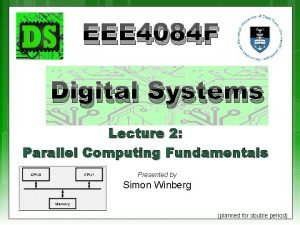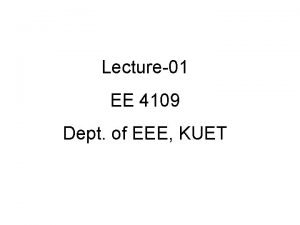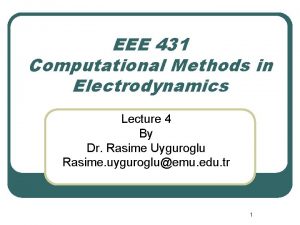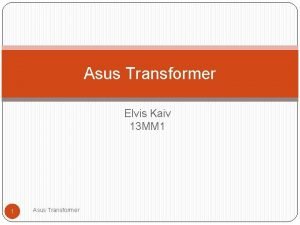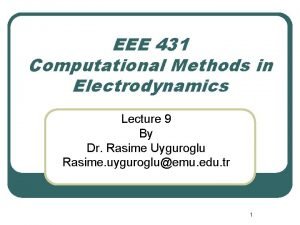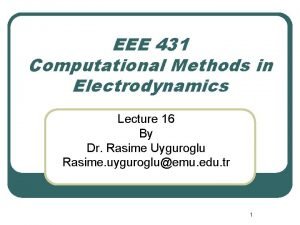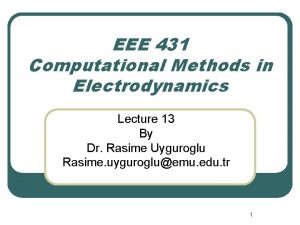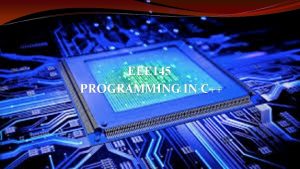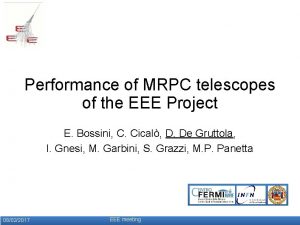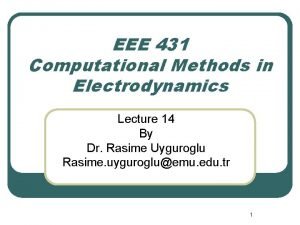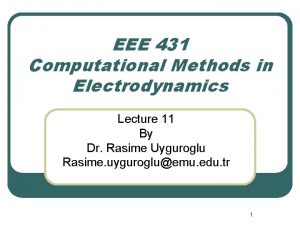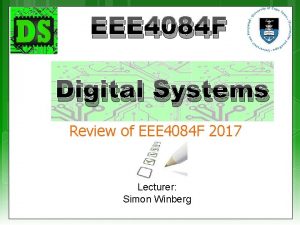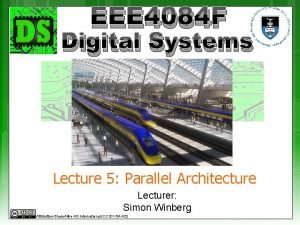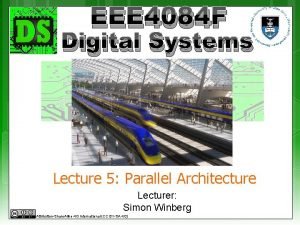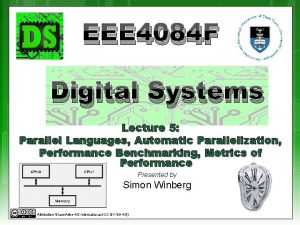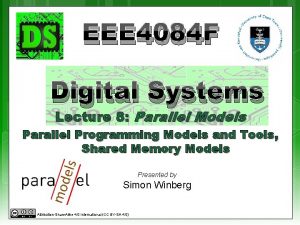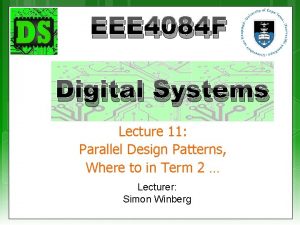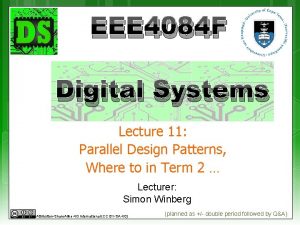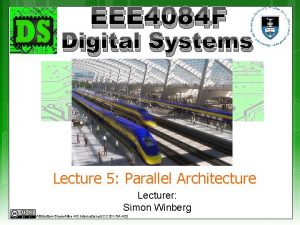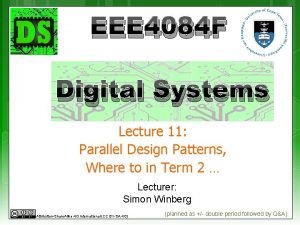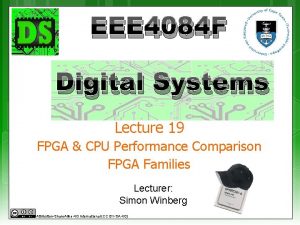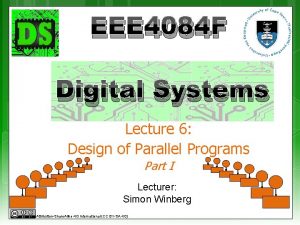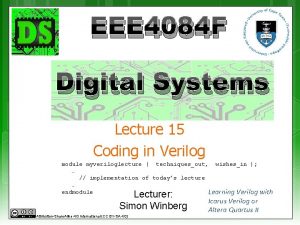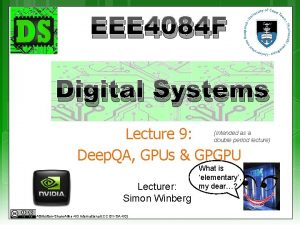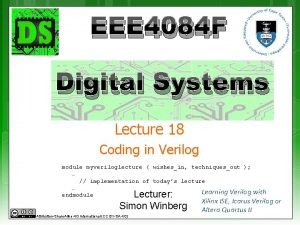EEE 4084 F Digital Systems Lecture 8 Parallel


























![Partitioned memory [a 1 a 2 … am-1] main() starts [b 1 b 2 Partitioned memory [a 1 a 2 … am-1] main() starts [b 1 b 2](https://slidetodoc.com/presentation_image_h/32fc83b09c6de717e8712f347dd0c1f0/image-27.jpg)
![Interlaced* memory [a 1 a 3 a 5 a 7 … an-2] main() starts Interlaced* memory [a 1 a 3 a 5 a 7 … an-2] main() starts](https://slidetodoc.com/presentation_image_h/32fc83b09c6de717e8712f347dd0c1f0/image-28.jpg)



- Slides: 31

EEE 4084 F Digital Systems Lecture 8: Parallel Models mod els Parallel Programming Models and Tools, Shared Memory Models Presented by Simon Winberg Attribution-Share. Alike 4. 0 International (CC BY-SA 4. 0)

Lecture Overview Parallel Programming Models Parallel System Approaches Parallel Programming Tools Parallelizing Compilers Shared Memory Models Shared Memory Terms

Parallel Programming Models EEE 4084 F

L 08 - Linked Reading Structures for parallel processing D. Aspinall Pub date: 1990 Parallel processing is employed to achieve high performance by replication or a unique function by interconnecting di�erent processes. In each case the engineering problem, of providing the structure to interconnect the processors, is a combination of issues concerning not only the implementation technology but also the needs of the application. The concepts of geometric parallelism and algorithmic parallelism are introduced along with the concepts of granularity and degree of parallelism. The author discusses parallel processing paradigms and performance metrics such as latency, response crisis time and stimulus crisis time. The author discusses multi-computer systems; interconnection pathway, geometric parallelism by shared pathways, stars, rings and other topologies and the implementation of algorithmic parallelism. Parallelism within the mainframe computer is discussed. The von Neuman machine (processor-memory pair), e�ect of a technology performance ratio; parallelism in the processor, pipelined computers and array computers. File: L 05 - 00084372 - Structures for parallel processing. pdf Aspinall, D. "Structures for parallel processing. " Computing & Control Engineering Journal 1. 1 (1990): 15 -22. DOI: 10. 1049/cce: 19900005 This paper, which is of a later date than Flynn’s work, presents additional parallel processing models, particularly ones that are not fully accurately for by Flynn’s taxonomy.

Aspinall: structures of parallel processing Parallel processing (author’s description): systems which allow more than one particular process to be active at any given instant. Geometric Parallelism (SIMD*): all data are available at once and each node operates on a unique portion of it according to the same program of instructions Algorithmic Parallelism: pattern of linkages by which the elements communicate with each other. Information flows from element to element in sequence to provide a result. * This acronym will be encountered in next lecture = processing node

Aspinall: structures of parallel processing 3 x dimensions for the spaces of parallel processing… Process level Granularity Degree of Parallelism (DOP) Let’s look at each one briefly…

Aspinall: structures of parallel processing 3 x dimensions for the spaces of parallel processing… Process instruction level: This is the lowest level E. g. Register transfer logic, instruction procedure or program. regs Granularity Degree of Parallelism (DOP)

Aspinall: structures of parallel processing 3 x dimensions for the spaces of parallel processing… Process level: e. g. register transfer logic, instruction procedure or program. regs Granularity: Ratio of the amount of computation (processing instructions per datum) to the amount of communication (transfer cost per datum). f() i. e. instructions : communications or result 1: N fine grained (high interdependence, each result needs a lot of communication, much of the data) 1: 1 medium grained e. g. sum(X) N: 1 course grained (low interdependence, each computation needs little or no other data) e. g. X[1: 10]=0 da ta instruction Degree of Parallelism (DOP)

Aspinall: structures of parallel processing instruction 3 x dimensions for the spaces of parallel processing… f() da ta Process level: e. g. register transfer logic, instruction procedure or program. Granularity: ratio of amount computation to communication i. e. instructions : communications or result 1: N fine grained (high interdependence) 1: 1 medium grained e. g. sum(X) N: 1 course grained (low interdependence) e. g. X[1: 10]=0 Degree of Parallelism (DOP): regs How many operations can be simultaneously f 1 f 2 executed by a computer. (Useful for f 3 predicting potential performance of parallel # functions programs). running together?

Parallel System Approaches Loaded & run when needed, time-shared system (very basic approach) Communication by shared memory Transputer paradigm: communicating by message passing – nowadays more commonly referred to as Message Passing (MP) model Pipelined: stages of processing that runs in lockstep. Intermediate accumulator registers (result registers between stages) equals the degree of parallelism. Maximum parallelism achieved when stages fully synchronisation (i. e. no stalls). Computer Array/Grid: mesh structure, neighbouring nodes share data (from Aspinall, 1990)

Parallel Programming Models Parallel Programming Models: at k o Lo ese th Data parallelism vs. Task parallelism Explicit parallelism / Implicit parallelism Shared memory / Distributed memory Other parallel programming paradigms Object-oriented Functional and logic

Data parallelism Data-parallel = Parallel programs that emphasize concurrent execution of the same task on different data elements Most programs for scalable parallel computers are data parallel in nature

Task Parallel Task parallel = Parallel programs that emphasize the concurrent execution of different tasks on the same or different data Uses: Modularity reasons Parallel programs, structured as a task- parallel composition of data-parallel components is common.

Data vs. Task Parallel Examples Data parallelism Task Parallelism

General Parallel Programming Models Explicit Parallelism The programmer specifies directly the activities of the multiple concurrent threads of control that forms the parallel computation. Provides the programmer with more control over program behaviour and hence can be used to achieve higher performance. Implicit Parallelism The programmer provides high-level specification of program behaviour. The compiler/library/framework needs to provide the means to implement the parallelism correctly and efficiently.

Parallel Programming Tools Parallel Virtual Machine (PVM) Distributed memory, explicit parallelism PThreads Shared memory, explicit parallelism Message-Passing Interface (MPI) Distributed memory, explicit parallelism Open. MP Shared memory, explicit parallelism Parallelizing Compilers Implicit parallelism

Parallelizing Compilers Automatically transform a sequential program into a parallel program. Finds loops whose iterations can be executed in parallel. Identifies data dependencies and orders the execution accordingly Often done in stages.

18 Types of Data Dependences: used to determine what loops can or cannot be run in parallel. Flow dependence – Read-After-Write (RAW). A true dependence as read a value after it has been written into a variable. Anti-dependence - Write-After-Read (WAR). Writes new value into a variable after the old value has been read. Output dependence - Write-After-Write (WAW). Write a new value into a variable and then later write another value into the same variable.

Example – data dependencies Dependencies …. line 1: 2: 3: 4: A B C A = = 90; A; A + D 5; Flow dependence on A from line 1 to 2, and from 1 to 3. … Anti dependence on A from line 2 to 4 and from line 3 to 4. … Output dependence on A between line 1 and stmt 4.

Example 1 Can this code be parallelized? line 1: for i = 1 to 1000 2: A(i) = B(i) + C(i) 3: D(i) = A(i) 4: next answer: • YES: There is a flow dependence on A(i) from line 1 to 2 in an iteration, but no dependences between any iterations. • Each iteration reads and writes to a different location in the array A, thus this loop can be executed in parallel – and even better we could execute the loop iterations in any order (so if some take longer to run than others that is OK). • A parallelizing compiler would split the 1000 iterations among the number of cores available

Example 2 Can this code be parallelized? answer: line 1: for i = 1 to 1000 2: A(i) = B(i) + C(i) 3: D(i) = A(i+1) 4: next • YES – if you have a good compiler: This example clearly contains an antidependence from line 2 to 1… • But in the subsequent iteration a WRITE will be done after we have already READ it in the previous iteration. • Line 2 is meant to read an old value of A(i+1) before the same location will be written over in the next loop iteration. • If the iterations were spread among e. g. 4 threads, then thread #2 could have already written a new value to A(251) in its first loop iteration, long before thread #1 tries to read (the old value) in its last loop, iteration 250. • So the compiler could chicken out and say it is not parallelizable – or it could realize that this problem only occurs at the boundaries and attempt to modify the loop to solve the problem, e. g. using saving the last A(i+1) in temp variable.

EEE 4084 F Shared Memory Models

Shared Memory Model Tasks share a common address space, can read and write to memory asynchronously. Memory control access is needed (e. g. , to cater for data dependencies), such as: Locks and semaphores to control access to shared memory. In this model, the notion of tasks ‘owning’ data is lacking, so there is no need to specify explicitly the communication of data between tasks.

Shared Memory Model: pros and cons Adv: often allows program development to be simplified (e. g. compared to message passing, discussed in a later lecture). Adv: Keeping data local to processor working on it conserves memory accesses (reducing cache refreshes, bus traffic and the like that occurs when multiple processors use the same data). Disad: tends to become more difficult to understand manage data locality, which may detract from the overall system performance.

Using a Mutex using mutexes so that neighbours are forced to talk (an adapted dining philosophers problem) A mutex provides a means to protect parts of code so that only one thread runs that piece of code at a time The mutex operations are lock : enter the protected code unlock : exit protected code / release key C code snippets for using a mutex #include <pthread. h> // this is the library usually used // instantiate a mutex: pthread_mutex_t mutex; // initialize the mutex pthread_mutex_init(&mutex, NULL); // lock the mutex pthread_mutex_lock(&mutex); // unlock the mutex pthread_mutex_unlock(&mutex); See example code at: http: //apiexamples. com/c/pthread_mutex_lock. html

Introducing to some important terms related to shared memory Using scalar product pthreads type implementation for scenarios…
![Partitioned memory a 1 a 2 am1 main starts b 1 b 2 Partitioned memory [a 1 a 2 … am-1] main() starts [b 1 b 2](https://slidetodoc.com/presentation_image_h/32fc83b09c6de717e8712f347dd0c1f0/image-27.jpg)
Partitioned memory [a 1 a 2 … am-1] main() starts [b 1 b 2 … bm-1] Thread 1 [am am+1 am+2 … an] sum 1 [bm bm+1 bm+2 … bn] Thread 2 Assuming a 2 -core machine sum 2 Vectors in global / shared memory main() sum = sum 1+sum 2 a 1 b 1 2 2 Memory access by thread
![Interlaced memory a 1 a 3 a 5 a 7 an2 main starts Interlaced* memory [a 1 a 3 a 5 a 7 … an-2] main() starts](https://slidetodoc.com/presentation_image_h/32fc83b09c6de717e8712f347dd0c1f0/image-28.jpg)
Interlaced* memory [a 1 a 3 a 5 a 7 … an-2] main() starts [b 1 b 3 b 5 b 7 … bn-2] Thread 1 [a 2 a 4 a 6 … an-1] sum 1 [b 2 b 4 b 6 … bn-1] Thread 2 Vectors in global / shared memory main() sum = sum 1+sum 2 a b sum 2 Assuming a 2 core machine * Data striping, interleaving and interlacing usually means the same thing. Memory access by thread

Memory Partitioning Terms Contiguous Partitioned (or separated or split) Interleaved/interlaced (or alternating or data striping) Interleaved – small stride (e. g. one word stride) Interleaved – large strides (e. g. row of image pixels at a time) (the ‘stride’ in data interleaving or data striping refers to the size of the blocks alternated, generally this is fixed but could be changeable, e. g. the last stride might be smaller to avoid padding data. )

What’s Next? ? Thursday 2 pm: Seminar #2 first student group seminar CH 1 -A Retrospective on High Performance Embedded Computing CH 2 -Representative Example of a High Performance Embedded Computing System presented by: Alexandra Barry, Nicholas Antonaides, Edwin Samuels Thursday 3 pm: Prac Prep Introduction to Open. CL (towards Prac 3)

Disclaimers and copyright/licensing details I have tried to follow the correct practices concerning copyright and licensing of material, particularly image sources that have been used in this presentation. I have put much effort into trying to make this material open access so that it can be of benefit to others in their teaching and learning practice. Any mistakes or omissions with regards to these issues I will correct when notified. To the best of my understanding the material in these slides can be shared according to the Creative Commons “Attribution-Share. Alike 4. 0 International (CC BY-SA 4. 0)” license, and that is why I selected that license to apply to this presentation (it’s not because I particulate want my slides referenced but more to acknowledge the sources and generosity of others who have provided free material such as the images I have used). Image sources: Pixabay http: //pixabay. com Stop watch slides 1 & 14, Gold bar: Wikipedia (open commons) books clipart: http: //www. clker. com (open commons)
 Q6 4084
Q6 4084 01:640:244 lecture notes - lecture 15: plat, idah, farad
01:640:244 lecture notes - lecture 15: plat, idah, farad Parallel and distributed computing lecture notes
Parallel and distributed computing lecture notes Kuet eee
Kuet eee Analog communication
Analog communication Eee 322
Eee 322 Eee 121
Eee 121 Eee 431
Eee 431 Eee 302
Eee 302 Eee 302
Eee 302 Tahvel.edu.eee
Tahvel.edu.eee Eee 431
Eee 431 Eee 431
Eee 431 Eee 431
Eee 431 Eee 431
Eee 431 Eee 145
Eee 145 Lecc
Lecc Huffman coding
Huffman coding Eee 431
Eee 431 Eee 431
Eee 431 Eee g
Eee g Eee 302
Eee 302 Dot product
Dot product Eee
Eee ëëë
ëëë Eee
Eee Android asus eee pc
Android asus eee pc Hku eee lab
Hku eee lab Pdf cute
Pdf cute Diu eee faculty
Diu eee faculty Eee
Eee Eee components
Eee components
